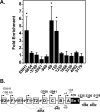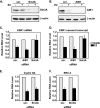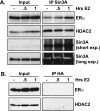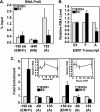Repression of ESR1 through actions of estrogen receptor alpha and Sin3A at the proximal promoter
- PMID: 19620290
- PMCID: PMC2738295
- DOI: 10.1128/MCB.00383-09
Repression of ESR1 through actions of estrogen receptor alpha and Sin3A at the proximal promoter
Abstract
Gene expression results from the coordinated actions of transcription factor proteins and coregulators. Estrogen receptor alpha (ERalpha) is a ligand-activated transcription factor that can both activate and repress the expression of genes. Activation of transcription by estrogen-bound ERalpha has been studied in detail, as has antagonist-induced repression, such as that which occurs by tamoxifen. How estrogen-bound ERalpha represses gene transcription remains unclear. In this report, we identify a new mechanism of estrogen-induced transcriptional repression by using the ERalpha gene, ESR1. Upon estrogen treatment, ERalpha is recruited to two sites on ESR1, one distal (ENH1) and the other at the proximal (A) promoter. Coactivator proteins, namely, p300 and AIB1, are found at both ERalpha-binding sites. However, recruitment of the Sin3A repressor, loss of RNA polymerase II, and changes in histone modifications occur only at the A promoter. Reduction of Sin3A expression by RNA interference specifically inhibits estrogen-induced repression of ESR1. Furthermore, an estrogen-responsive interaction between Sin3A and ERalpha is identified. These data support a model of repression wherein actions of ERalpha and Sin3A at the proximal promoter can overcome activating signals at distal or proximal sites and ultimately decrease gene expression.
Figures








Similar articles
-
Maximum growth and survival of estrogen receptor-alpha positive breast cancer cells requires the Sin3A transcriptional repressor.Mol Cancer. 2010 Sep 29;9:263. doi: 10.1186/1476-4598-9-263. Mol Cancer. 2010. PMID: 20920219 Free PMC article.
-
Estrogen receptor alpha represses transcription of early target genes via p300 and CtBP1.Mol Cell Biol. 2009 Apr;29(7):1749-59. doi: 10.1128/MCB.01476-08. Epub 2009 Feb 2. Mol Cell Biol. 2009. PMID: 19188451 Free PMC article.
-
The silencing mediator of retinoic acid and thyroid hormone receptor (SMRT) corepressor is required for full estrogen receptor alpha transcriptional activity.Mol Cell Biol. 2007 Sep;27(17):5933-48. doi: 10.1128/MCB.00237-07. Epub 2007 Jun 25. Mol Cell Biol. 2007. PMID: 17591692 Free PMC article.
-
Estrogen Receptor Alpha Splice Variants, Post-Translational Modifications, and Their Physiological Functions.Cells. 2023 Mar 14;12(6):895. doi: 10.3390/cells12060895. Cells. 2023. PMID: 36980236 Free PMC article. Review.
-
ERα in the Control of Mitochondrial Function and Metabolic Health.Trends Mol Med. 2021 Jan;27(1):31-46. doi: 10.1016/j.molmed.2020.09.006. Epub 2020 Oct 2. Trends Mol Med. 2021. PMID: 33020031 Review.
Cited by
-
A cluster of noncoding RNAs activates the ESR1 locus during breast cancer adaptation.Nat Commun. 2015 Apr 29;6:6966. doi: 10.1038/ncomms7966. Nat Commun. 2015. PMID: 25923108 Free PMC article.
-
Pin1 modulates ERα levels in breast cancer through inhibition of phosphorylation-dependent ubiquitination and degradation.Oncogene. 2014 Mar 13;33(11):1438-47. doi: 10.1038/onc.2013.78. Epub 2013 Apr 1. Oncogene. 2014. PMID: 23542176 Free PMC article.
-
Intrinsic and Extrinsic Factors Governing the Transcriptional Regulation of ESR1.Horm Cancer. 2020 Aug;11(3-4):129-147. doi: 10.1007/s12672-020-00388-0. Epub 2020 Jun 26. Horm Cancer. 2020. PMID: 32592004 Free PMC article. Review.
-
Designer monotransregulators provide a basis for a transcriptional therapy for de novo endocrine-resistant breast cancer.Mol Med. 2010 Jan-Feb;16(1-2):10-8. doi: 10.2119/molmed.2009.00107. Epub 2009 Nov 17. Mol Med. 2010. PMID: 19946606 Free PMC article.
-
Epigenetic regulation of estrogen signaling in breast cancer.Epigenetics. 2013 Mar;8(3):237-45. doi: 10.4161/epi.23790. Epub 2013 Jan 30. Epigenetics. 2013. PMID: 23364277 Free PMC article. Review.
References
-
- Alarid, E. T., N. Bakopoulos, and N. Solodin. 1999. Proteasome-mediated proteolysis of estrogen receptor: a novel component in autologous down-regulation. Mol. Endocrinol. 131522-1534. - PubMed
-
- An, J., R. C. Ribeiro, P. Webb, J. A. Gustafsson, P. J. Kushner, J. D. Baxter, and D. C. Leitman. 1999. Estradiol repression of tumor necrosis factor-alpha transcription requires estrogen receptor activation function-2 and is enhanced by coactivators. Proc. Natl. Acad. Sci. USA 9615161-15166. - PMC - PubMed
-
- Ayer, D. E., Q. A. Lawrence, and R. N. Eisenman. 1995. Mad-Max transcriptional repression is mediated by ternary complex formation with mammalian homologs of yeast repressor Sin3. Cell 80767-776. - PubMed
-
- Berger, S. L. 2007. The complex language of chromatin regulation during transcription. Nature 447407-412. - PubMed
-
- Berkenstam, A., H. Glaumann, M. Martin, J. A. Gustafsson, and G. Norstedt. 1989. Hormonal regulation of estrogen receptor messenger ribonucleic acid in T47D and MCF-7 breast cancer cells. Mol. Endocrinol. 322-28. - PubMed
Publication types
MeSH terms
Substances
Grants and funding
LinkOut - more resources
Full Text Sources
Miscellaneous
